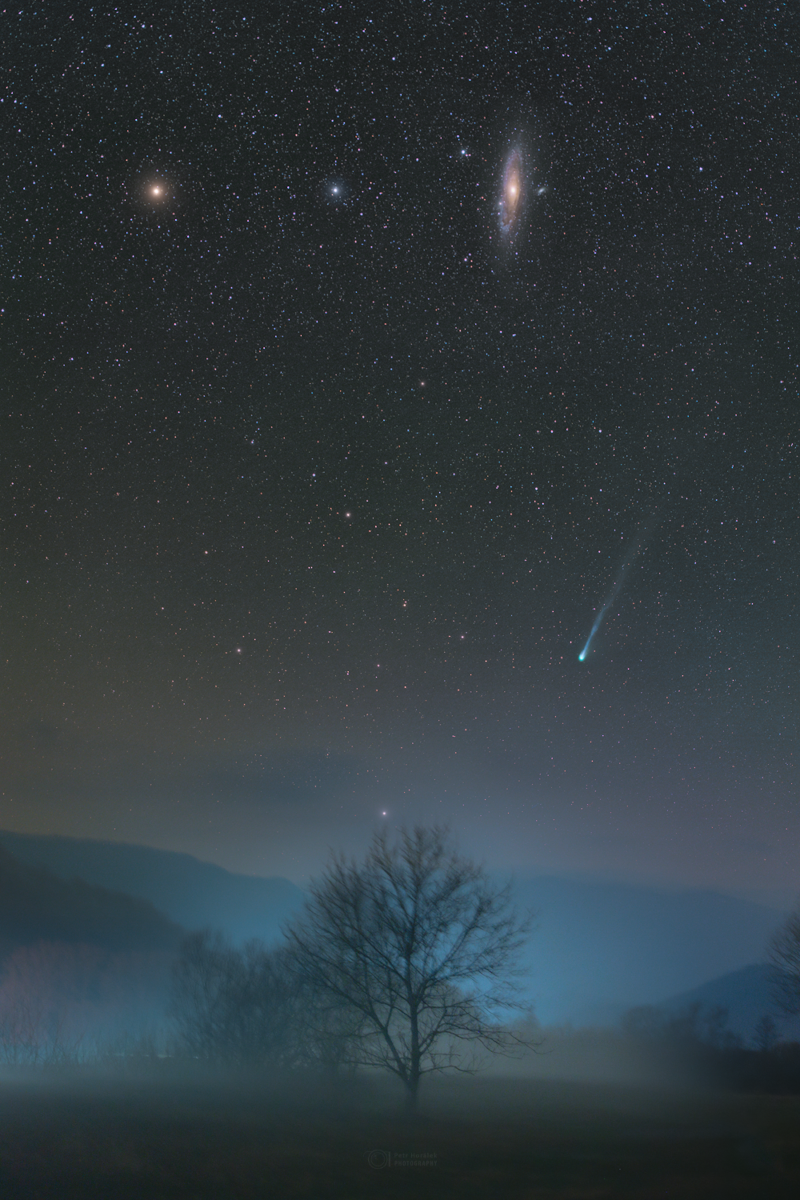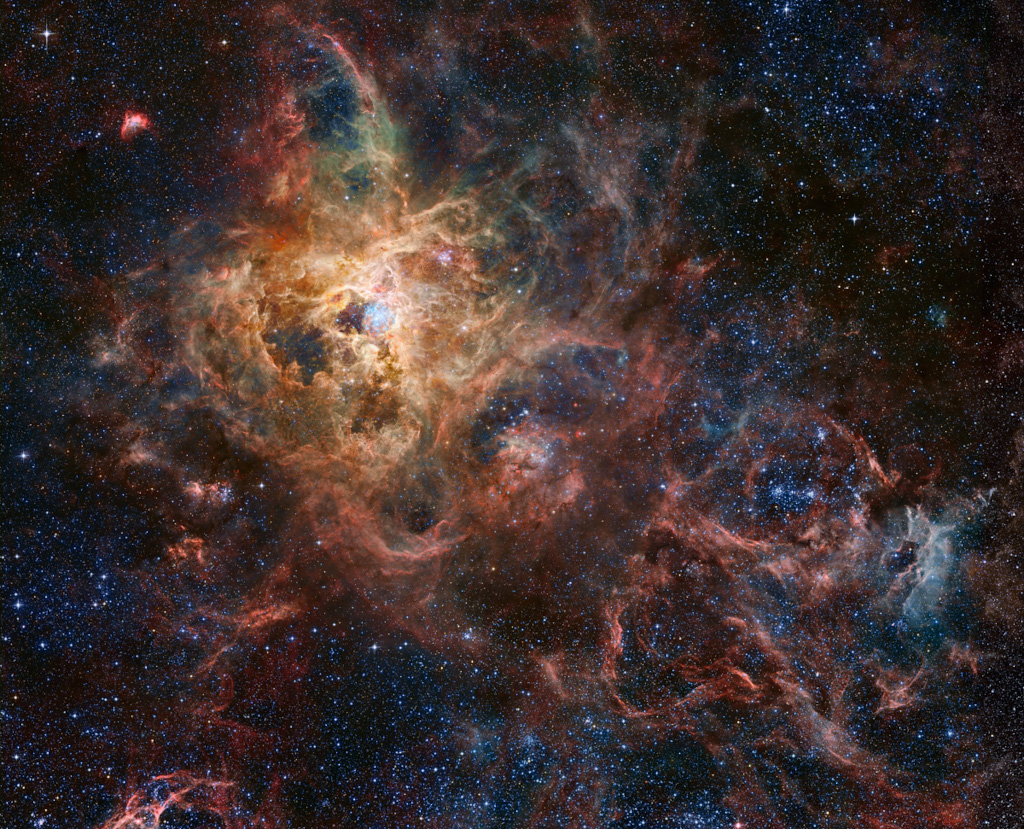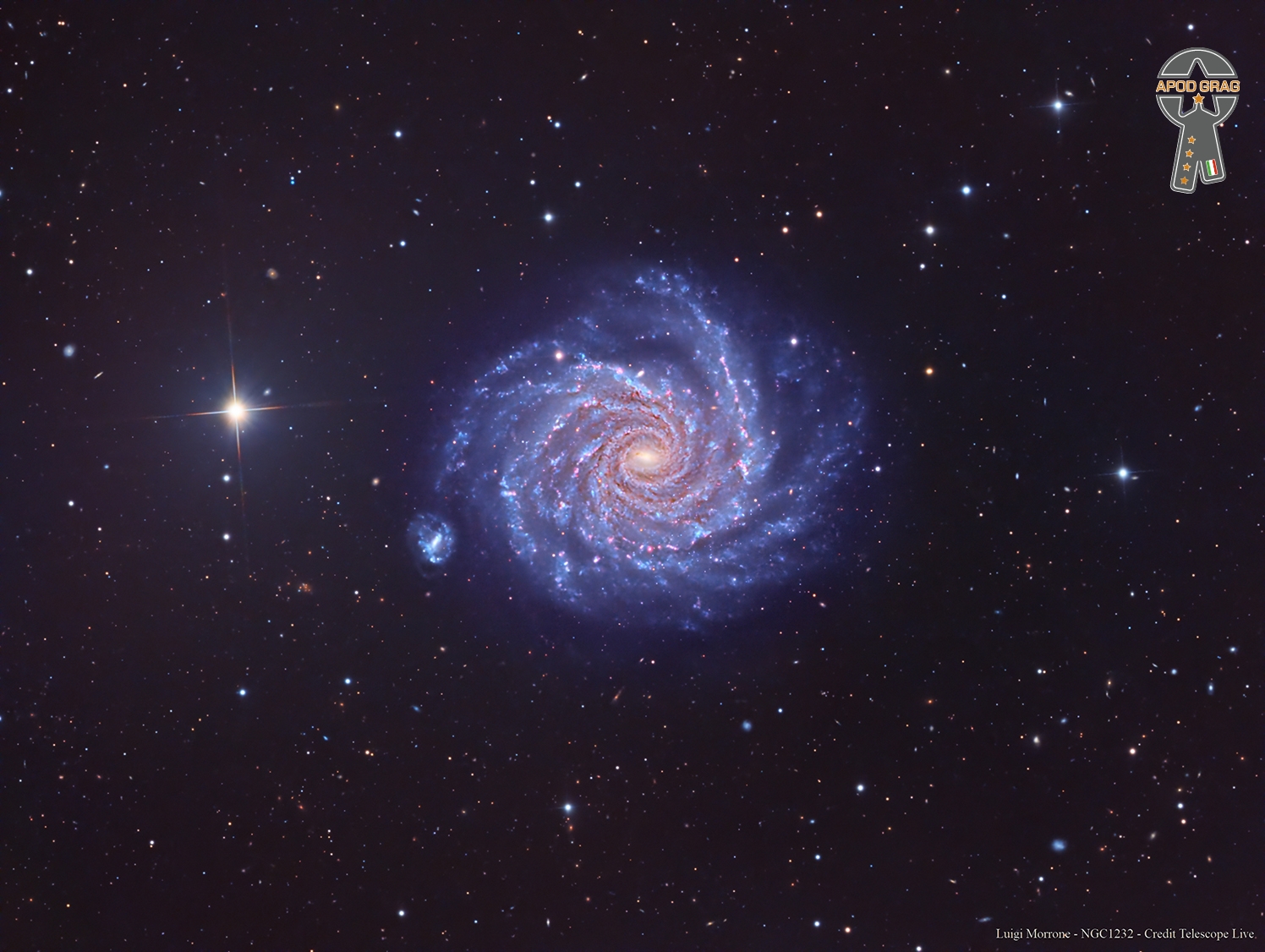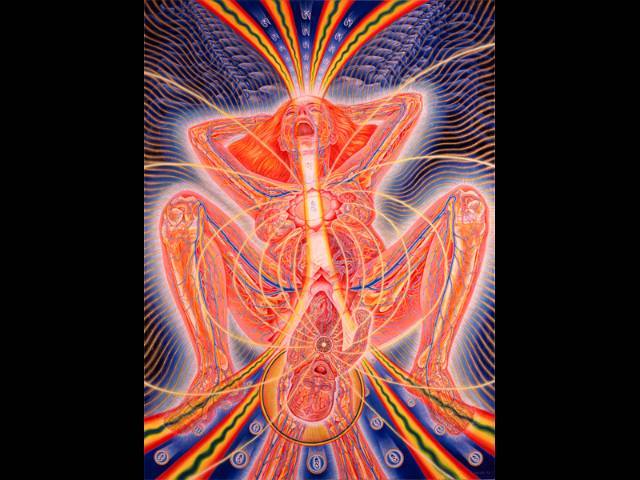Comet 12P/Pons-Brooks is growing brighter. Currently visible with small telescopes and binoculars the Halley-type comet could reach naked eye visibility in the coming weeks. Seen despite a foggy atmosphere, the comet’s green coma and long tail hover near the horizon, in this well-composed deep night skyscape from Revuca, Slovakia recorded on March 5. In the sky above the Halley-type comet, the Andromeda (right) and Triangulum galaxies flank bright star Mirach, beta star of the constellation Andromeda. The two spiral galaxies are members of our local galaxy group and over 2.5 million light-years distant. Comet Pons-Brooks is a periodic visitor to the inner Solar System and less than 14 light-minutes away. Reaching its perihelion on April 21, this comet should be visible in the sky during the April 8 total solar eclipse.

Ustad Zakir Hussain (born 9 March 1951) is an Indian tabla player, composer, percussionist, music producer and film actor. He is the eldest son of tabla player Alla Rakha. He is widely considered as one of the greatest tabla players of all time.
He was awarded the Padma Shri in 1988, the Padma Bhushan in 2002, and the Padma Vibhushan in 2023, by the Government of India. On 8 February 2009 for 51st Grammy Awards, Hussain won the Grammy in the Contemporary World Music Album category for his collaborative album Global Drum Projectwith Mickey Hart, Sikiru Adepoju & Giovanni Hidalgo.
He was also awarded the Govt of India’s Sangeet Natak Akademi Award in 1990, Sangeet Natak Akademi Fellowship, Ratna Sadsya in 2018. In 1999, he was awarded the United States National Endowment for the Arts‘ National Heritage Fellowship, the highest award given to traditional artists and musicians. Hussain has a total of 5 Grammy awards equalling the tallies of the late sitar maestro Ravi Shankar and the master conductor Zubin Mehta; they are all in top spot, incidentally, on the list of Indians with the most Grammy wins. He received 3 Grammy Awards in February 2024.
see full post...Randolph Denard Ornette Coleman (March 9, 1930 – June 11, 2015 Fort Worth, TX) was an American jazzsaxophonist, trumpeter, violinist, and composer. He is best known as a principal founder of the free jazzgenre, a term derived from his 1960 album Free Jazz: A Collective Improvisation. His pioneering works often abandoned the harmony-based composition, tonality, chord changes, and fixed rhythm found in earlier jazz idioms. Instead, Coleman emphasized an experimental approach to improvisation, rooted in ensemble playing and blues phrasing. AllMusic called him “one of the most beloved and polarizing figures in jazz history,” noting that while “now celebrated as a fearless innovator and a genius, he was initially regarded by peers and critics as rebellious, disruptive, and even a fraud.”
Born and raised in Fort Worth, Texas, Coleman taught himself to play the saxophone when he was a teenager. He began his musical career playing in local R&B and bebop groups, and eventually formed his own group in Los Angeles featuring members such as Ed Blackwell, Don Cherry, Charlie Haden, and Billy Higgins. In November 1959, his quartet began a controversial residency at the Five Spot jazz club in New York City and he released the influential album The Shape of Jazz to Come, his debut LP on Atlantic Records. Coleman’s subsequent Atlantic releases in the early 1960s would profoundly influence the direction of jazz in that decade, and his compositions “Lonely Woman” and “Broadway Blues” became genre standards that are cited as important early works in free jazz.
In the mid 1960s, Coleman left Atlantic for labels such as Blue Note and Columbia Records, and began performing with his young son Denardo Coleman on drums. He explored symphonic compositions with his 1972 album Skies of America, featuring the London Symphony Orchestra. In the mid-1970s, he formed the group Prime Time and explored electric jazz-funk and his concept of harmolodic music. In 1995, Coleman and his son Denardo founded the Harmolodic record label. His 2006 album Sound Grammar received the Pulitzer Prize for Music, making Coleman the second jazz musician ever to receive the honor.
see full post...Dorothy Jacqueline Keely (March 9, 1928 – December 16, 2017), professionally known as Keely Smith, was an American jazz and popular music singer, who performed and recorded extensively in the 1950s with then-husband Louis Prima, and throughout the 1960s as a solo artist.
Smith married Prima in 1953. The couple were stars throughout the entertainment business, including stage, television, motion pictures, hit records, and cabaret acts. They won a Grammy in 1959, its inaugural year, for their smash hit, “That Old Black Magic”, which remained on the charts for 18 weeks. Smith was born in Norfolk, Virginia; her ancestry was Irish and Cherokee.
see full post...Friday March 8th 6pm Shabbat Service with Inbal Sharett-Singer, Jayson Rodovsky, Jeff Bailey, Pete Whitman and mick laBriola.
see full post...The Tarantula Nebula, also known as 30 Doradus, is more than a thousand light-years in diameter, a giant star forming region within nearby satellite galaxy the Large Magellanic Cloud. About 180 thousand light-years away, it’s the largest, most violent star forming region known in the whole Local Group of galaxies. The cosmic arachnid sprawls across this magnificent view, an assembly of image data from large space- and ground-based telescopes.Within the Tarantula (NGC 2070), intense radiation, stellar winds, and supernova shocks from the central young cluster of massive stars cataloged as R136 energize the nebular glow and shape the spidery filaments. Around the Tarantulaare other star forming regions with young star clusters, filaments, and blown-out bubble-shaped clouds. In fact, the frame includes the site of the closest supernova in modern times, SN 1987A, at lower right. The rich field of view spans about 2 degrees or 4 full moons in the southern constellation Dorado. But were the Tarantula Nebula closer, say 1,500 light-years distant like the Milky Way’s own star forming Orion Nebula, it would take up half the sky.

see full post...
Juan de Dios Ventura Soriano (8 March 1940 – 28 July 2021), better known as Johnny Venturanicknamed El Caballo Mayor, was a Dominican singer and band leader of merengue and salsa.
In 2004, he received the Latin Grammy Award for Best Merengue/Bachata Album for his album Sin Desperdicio; also, he was nominated for Best Merengue Album (2006), Best Contemporary Tropical Album(2010) and Best Salsa Album (2016) categories. In 2006, he received the Latin Grammy Lifetime Achievement Award, and in 2022, he entered the Latin Songwriters Hall of Fame.
The merengue legend was a legislator of the Lower House between 1982 and 1986. He also served as vicemayor of Santo Domingo from 1994 to 1998, and as mayor of Santo Domingo from 1998 to 2002.
see full post...Richard George Fariña (March 8, 1937 – April 30, 1966) was an American folksinger, songwriter, poet and novelist.
Fariña was born in Brooklyn, New York, United States, the son of an Irish mother, Theresa Crozier, and a Cuban father of Galician origin, also named Richard Fariña. He grew up in the Flatbush neighborhood of Brooklyn and attended Brooklyn Technical High School. He earned an academic scholarship to Cornell University, starting as an engineering major, but later switching to English. While at Cornell he published short stories for local literary magazines and for national periodicals, including Transatlantic Review and Mademoiselle. Fariña became good friends with Thomas Pynchon, David Shetzline, and Peter Yarrowwhile at Cornell. He was suspended for alleged participation in a student demonstration against campus regulations, and although he later resumed his status as a student, he dropped out in 1959, just before graduation. On April 30, 1966, two days after the publication of his novel, Fariña attended a book-signing ceremony at a Carmel Valley Village bookstore, the Thunderbird. Later that night Fariña was killed on a motorcycle ride heading east toward the rural Cachagua area of Carmel Valley.
see full post...Gábor István Szabó (March 8, 1936 – February 26, 1982) was a Hungarian-American guitarist whose style incorporated jazz, pop, rock, and Hungarian music.
Szabó was born in Budapest, Hungary. He began playing guitar at the age of 14. In the aftermath of the Hungarian revolution of 1956, he moved to California and later attended the Berklee College of Music in Boston between 1958 and 1960. In 1961, Szabó became member of a quintet that was led by Chico Hamilton and included Charles Lloyd,[2]playing what has been described as chamber jazz, with “a moderate avant-gardism.” Szabó was influenced by the rock music of the 1960s, particularly the use of feedback. In 1965 he was in a jazz pop group led by Gary McFarland, then worked again with Lloyd in an energetic quartet with Ron Carter and Tony Williams. The song “Gypsy Queen” from Szabó’s debut solo album Spellbinder became a hit for rock guitarist Carlos Santana. During the late 1960s, Szabó worked in a group with guitarist Jimmy Stewart. He started the label Skye Records with McFarland and Cal Tjader.
see full post...
George Edward Coleman (born March 8, 1935) is an American jazz saxophonist known for his work with Miles Davis and Herbie Hancock in the 1960s. In 2015, he was named an NEA Jazz Master.
Coleman was born in Memphis, Tennessee. He was taught how to play the alto saxophone in his teens by his older brother Lucian Adams, inspired (like many jazz musicians of his generation) by Charlie Parker. Among his schoolmates were Harold Mabern, Booker Little, Frank Strozier, Hank Crawford, and Charles Lloyd.
After working with Ray Charles, Coleman started working with B.B. King in 1953, at which point he switched to tenor saxophone.In 1956 Coleman moved to Chicago, along with Booker Little, where he worked with Gene Ammons and Johnny Griffin before joining Max Roach‘s quintet (1958–1959). Coleman recorded with organist Jimmy Smith on his album House Party (1957), along with Lee Morgan, Curtis Fuller, Kenny Burrell, and Donald Bailey. Moving to New York City with Max Roach in that year, he went on to play with Slide Hampton (1959–1962), Ron Carter, Jimmy Cobb, and Wild Bill Davis (1962), before joining Miles Davis’ quintet in 1963–1964.
see full post...John Smith Hurt (March 8, 1893– November 2, 1966), known as Mississippi John Hurt, was an American country blues singer, songwriter, and guitarist. Hurt was raised in Avalon, Mississippi and taught himself to play the guitar around the age of nine. He worked as a sharecropper and began playing at dances and parties, singing to a melodious fingerpickedaccompaniment. His first recordings, made for Okeh Records in 1928, were commercial failures, and he continued to work as a farmer.
Dick Spottswood and Tom Hoskins, a blues enthusiast, located Hurt in 1963 and persuaded him to move to Washington, D.C. He was recorded by the Library of Congress in 1964. This helped further the American folk music revival, which led to the rediscovery of many other bluesmen of Hurt’s era. Hurt performed on the university and coffeehouse concert circuit with other Delta blues musicians who were brought out of retirement. He also recorded several albums for Vanguard Records.
see full post...The most basic buleria marking progression uses just two chords: A and B♭. When accompanying a singer, the guitarist plays chords that follow the singer. When playing buleria as a solo piece, guitarists assemble rhythmic patterns, short chord progressions, and pre-composed or improvised falsetas to build a musical idea around a central theme.
see full post...NGC 1232, also known as the Eye of God Galaxy is an intermediate spiral galaxy about 60 million light-years away in the constellation Eridanus. It was discovered by German-British astronomer William Herschel on 20 October 1784.
It is dominated by millions of bright stars and dark dust, in spiral arms rotating about the center. Open clusters containing bright blue stars are sprinkled along these spiral arms, with dark lanes of dense interstellar dust between. Less visible are dimmer stars and interstellar gas, comprising such a high mass that they dominate the dynamics of the inner galaxy. Not visible is matter of unknown form called dark matter, needed to explain the motions of the visible material in the outer galaxy. The galaxy is approximately 200,000 light-years across. The galaxy’s spiral arms are not smooth and perturbed, leading to some suggesting a collision with a dwarf galaxy. However, some studies doubt this suggestion.

Alcide Louis “Slow Drag” Pavageau (March 7, 1888 – January 19, 1969) was an American jazz guitarist and double-bassist.
Pavageau was born in New Orleans, Louisiana.He started his career as a dancer, mastering a dance called the Slow Drag which resulted in his nickname. He learned the guitar as a young man from his cousin Ulysses Picou, a singer in New Orleans. Pavageau came from a musical family and was related to families like the Tios, Picous and Pirons who formed some of the earliest jazz bands. He played Buddy Petit, Bunk Johnson, and Herb Morand. Johnson bragged that he taught Louis Armstrong how to play cornet by ear. He started playing bass in 1927 when he was 39 years old and joined George Lewis‘s band from 1943 and also played in Bunk Johnson‘s band in New York City in 1945. He toured with Lewis through the end of the 1950s. In 1961, while playing with the Louis Cottrell Trio, he recorded New Orleans: The Living Legends for Riverside. He worked at Preservation Hall in the 1960s and recorded one album as a leader in 1965 in addition to frequent recording with Lewis.
see full post...Joseph Maurice Ravel (7 March 1875 – 28 December 1937) was a French composer, pianist and conductor. He is often associated with Impressionism along with his elder contemporary Claude Debussy, although both composers rejected the term. In the 1920s and 1930s Ravel was internationally regarded as France’s greatest living composer.
Born to a music-loving family, Ravel attended France’s premier music college, the Paris Conservatoire; he was not well regarded by its conservative establishment, whose biased treatment of him caused a scandal. After leaving the conservatoire, Ravel found his own way as a composer, developing a style of great clarity and incorporating elements of modernism, baroque, neoclassicism and, in his later works, jazz. He liked to experiment with musical form, as in his best-known work, Boléro (1928), in which repetition takes the place of development. Renowned for his abilities in orchestration, Ravel made some orchestral arrangements of other composers’ piano music, of which his 1922 version of Mussorgsky‘s Pictures at an Exhibition is the best known.
A slow and painstaking worker, Ravel composed fewer pieces than many of his contemporaries. Among his works to enter the repertoire are pieces for piano, chamber music, two piano concertos, ballet music, two operas and eight song cycles; he wrote no symphonies or church music. Many of his works exist in two versions: first, a piano score and later an orchestration. Some of his piano music, such as Gaspard de la nuit (1908), is exceptionally difficult to play, and his complex orchestral works such as Daphnis et Chloé (1912) require skilful balance in performance.
Ravel was among the first composers to recognise the potential of recording to bring their music to a wider public. From the 1920s, despite limited technique as a pianist or conductor, he took part in recordings of several of his works; others were made under his supervision.
see full post...